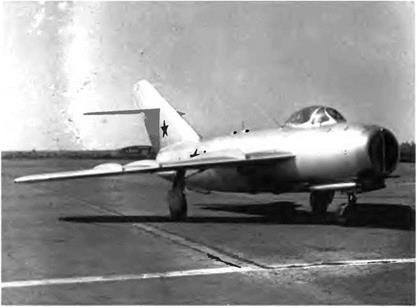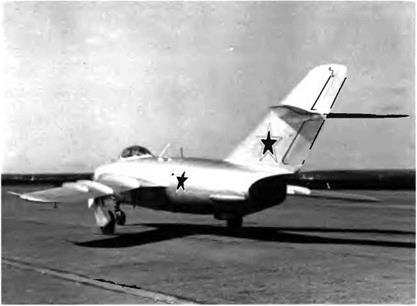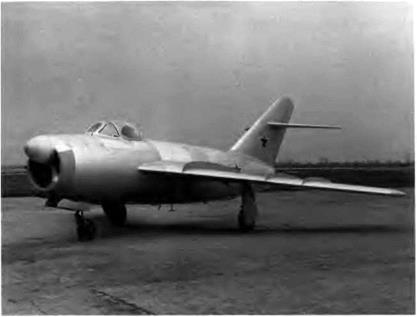MiG-17F / SP-2
The focus of this program was the performance of the RP-3 Kor – shun ("kite") ranging radar designed by the Slepushkin OKB. The Kor- shun-equipped MiG-17F was built in response to two directives from the USSR council of ministers, dated 10 June 1950 and 10 August 1951. These directives called for the development of a fighter “to intercept and destroy, day or night and whatever the weather conditions, any enemy bomber, reconnaissance aircraft, or escort fighter." The Kor – shun ranging radar used a Cartesian-coordinate scanning mode.
The SP-2, derived from the SI-2, differed from the basic MiG-17F in the following ways:
1. The fuselage nose section had to be modified
2. The N-37D cannon was removed, but the ammunition reserve for
|
The SP-2 was an experimental variant of the MiG-17F intended to assess the performance of the Korshun radar. |
the remaining NR-23 guns was increased to 90 and 120 rounds, respectively
3. Several systems were relocated
4. The airbrakes opened automatically at M 1.03 and retracted as soon as the aircraft’s speed dropped to M 0.97 (and they could still be operated manually)
5. The camera gun was moved to the right side of the engine air intake
6. The capacity of the rear fuselage tank was increased to 250 1 (66 US gallons) from 195 1 (51 US gallons)
G. A. Sedov conducted the factoiy tests between March and November 1951. State acceptance trials were carried out from 28 November to 29 December by Nil WS and PVO military pilots such as A. P. Suprun, Yu. A. Antipov, V. G. Ivanov, Ye. I. Dziuba, Ye. Ya. Savitskiy, and R. N. Sereda. Experiments with the Korshun radar proceeded in July and August 1951 on an 1-320 fighter prototype. The Korshun was basically a modified rendition of the Toriy-A, which was tested from February to May 1950 in an SP-1. Neither radar could operate in an automatic tracking mode.

|

|
Specifications and Performance of the SP-2
Source: MiG OKB |
The following extract from the final test report is especially noteworthy:
1. The SP-2’s performance meets the targets stipulated in the directives of the USSR council of ministers
2. The SP-2’s performance data are almost identical to those of the MiG-17F
3. The aircraft’s combat capabilities are limited because it is difficult for the pilot of a single-seater to follow up the Korshun data (searching for, approaching, and sighting the target) for several reasons: first, it is impossible to determine with sufficient accuracy the distance between the fighter and its target; second, it is impossible to reduce the aircraft’s speed quickly when approaching the target because of the poor efficiency of the airbrakes; and third, the radar is not very reliable
4. Taxiing and taking off with two 600-1 [158-US gallon] drop tanks is rather tricky because of the aircraft’s inertia
For these and other reasons the Nil WS put an end to the Korshun research program. The table above is quite noteworthy because it allows us to compare the design performance data outlined in the government directives with those of the SP-2











